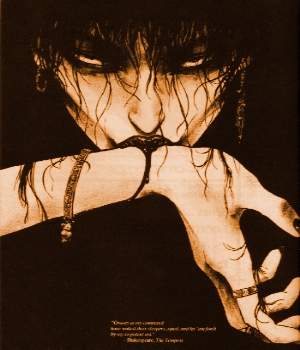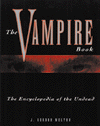


"Therefore with the same necessity with which the stone falls to earth, the hungry wolf buries its fangs in the flesh of its prey without the possibility of the knowledge that it itself is the destroyed as well as the destroyer." - Schopenhauer
In Western lore, vampires are most associated with the restless spirits of the dead, who, as revenants, return to harass and attack the living. The fear of the dead, and especially of the ability of the dead to vampirize the living, is ancient and universal. Anthropologist Sir James Frazer stated that fear of the dead, not reverence for the dead, has inspired throughout history the range of practices associated with death, especially the postdeath treatment of the corpse and its burial.
In Greeze and parts of Eastern Europe, the dead are dug up three to five years after burial, and the bones are examined to ascertain whether or not the soul has found peace. According to lore, if the body has not entirely decomposed, if the bones are dark and not white, or if bits of hair cling to the skull, the soul is not at rest.
The acient Egyptians believed the souls of the dead could return as vampires. And a Chaldean epic of the third millenium B.C. portrays the goddess Ishtar, who goes to the underworld to find her son/lover Tammuz, declaring, "I will cause the dead to arise and devour the living." The devouring most likely means destruction through a wasting illness.
Similarly, Chinese lore offers "hungry ghosts," voracious spirits of the dead who have no one living to feed them with the proper postmortem rituals and offerings.
Virtually all societies have established rituals to prevent the return of the dead (usually thorugh certain funeral and burial procedures), or to dispatch them should they find their way back to the living (usually by multilating or burning the corpse, believed to be the vehicle that sustains the revenant). The dead come back for various reasons: they committed suicide or were murderred; they died unrepentant of sins; they were victims (especially the first victims) of plagues or epidemics; they were not properly buried; or they had unfinished business with the living. The returning dead usually plague their immediate families first and then spread their mischidf to the community at large.
It is possible to be a vampire while still alive. Generally, such persons are witches, wizards, and sorcerers. In Africa, folklores hold that witches frequently indulge in vampirism, as well as in cannibalism and necrophagy. The witches leave their bodies and fly about in search of victims. They enter houses through the roofs and then enter the stomachs of sleeping persons. Inside, they wound the vital organs-especially the heart, liver, and lungs-with "secret spears" or else they suck out the heart. They also suck off the essence of the victim's blood. The victim immediately becomes ill and ulcerated and then dies.
African vampire witches also drink a brew in their rites that is the essence of human blood. According to M.J. Field in Religion and Medicine of the Ga People (1937, pp.142-143):
When the witches meet they are believe to gather 'round a pot called baisea.... The pot is often supposed to contain the "blood" of the victims. This "blood" appears to ordinary eyes as mere water, but it contains the vitality of the victim. And though the victim has lost none of his tangible blood and bleeds in the normal way when cut, the essential properties of his blood have been "sucked" and transferred to the pot to be drunk by the witches. Occasionally when a witch is arrested, confesses, and consents to reform, she begins by vomiting all the "blood" she has ever sucked.
Similarly, in Easter European and Russian lore, a chief occupation of certain witches, wizards, and sorcerers is to suck off the blood essence of humans and animals. Some of these magical adepts have the power to shape-shift into animal forms. In Romania, the term strigoi applies to both living witches and the vampiric dead. Among the Karachay, the oburs are shape-shifting witches or wizards who smear themselves with a magical salve, mount brooms, fly up chimneys in the forms of cats, and go in search of victims for blood. Once sated, the oburs return home by descending the chimneys on their brooms and resuming human form. In Russia, the term eretik is applied to both sorcerers and religious heretics who are fated to become vampires after death.
We also find in Easter European lore a strong link between the vampire and the werewolf, a human who lives under a curse of involuntary shape-shifting every full moon, going on a rampage of killing and destruction.
Amontg the Southern SLavs, the term vudkolak ("wolf's hair") refers to both a vampire and a vampire-werewolf-the latter being a sort of two-for-the-price-of-one creature. In parts of Europe, especially Romania, Greece, and East Prussia, folklore beliefs hold that when werewolves die, they become vampires.
Actual reports of vampirism, rather than the general folklore concerning vampires, usually began with people dying from a lingering disease. After some of these people died, neighbors dug up the corpses and observed a variety of unusual conditions, all signs of continuing life. The bodies had not decayed. The skin had a ruddy complexion and the hair and fingernails had continued to grow. Fresh flesh had appeared as the outer layer of skin had peeled off. Blood was present around the mouth and in the body when it was cut or punctured. If staked, the body reacted as if in pain. Occasionally, when a stake was thrust into the body, the corpse was heard to cry out. In northern Europe, reports of chewed-off appendages suggested to observers that vampires fed on themselves before leaving the grave to feed on others.
By far the most popular explanation of vampire reports was premature burial. Many people in the eighteenth and nineteenth century knew of catalepsy, a disease in which the person affected took on many of the symptoms of death; on occasion, such people were removed by the undertaker and even buried before they reawakened.
Others suggest that anomalous incidents of preservation of the body from its normal rate of decay accounted for the state of the exhumed bodies. Perhaps something in the soil or an unusual lack of air or moisture slowed the decay. Possibly the shiriek heard when the corpse was staked was the escape of trapped air. Similiarly, others suggested that what was being observed was simply the natural decay of the body. Most people were unaware of continued changes in the body after death, such as the loss of rigidity.
A consideration of the strengths and limitations of many explanations of vampires suggests that the belief in vampirism is a very old and possibly cultural response to an event that happens in all cultures-the ultimely death of a loved one as a result of childbirth, accident, or suicide, followed by an intense experience of interacting with the recently dead person. Given that brief, there are a variety of events, such as the irregular rate of decay of the soft flesh of corpses, taht could be cited as visible "proof" that vampires exist or as factors that on occasion correlate to their presence. Since "unnatural" deaths still occur, and people still have intense experiences with the dead (now usually thought of as encounters with ghosts or appirations), those people who also believe in vampires can point to those experiences as in some manner substantiating their beliefs. Thus, these experiences indicate the presence of vampires... we know vampires exist because of these experiences.

The above information was taken from "The Complete Vampire Companion" by Rosemary Ellen Guily
and
"The Vampire Book, The Encyclopedia of the Undead" by J. Gordon Melton

This page was Last Updated: August 10, 2001